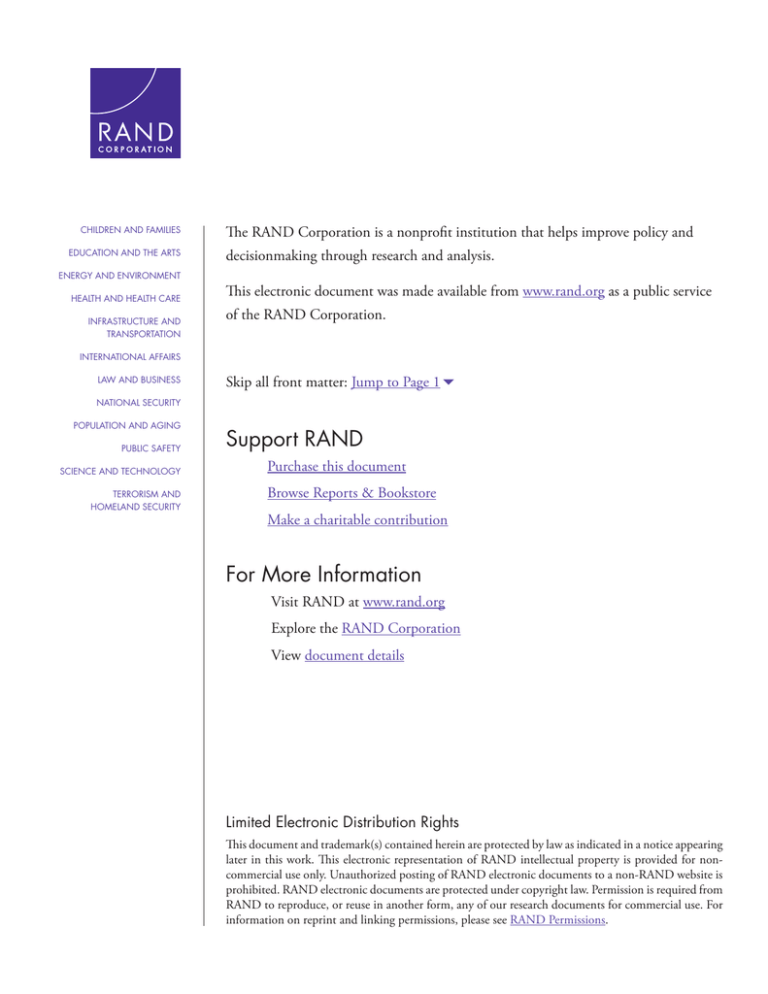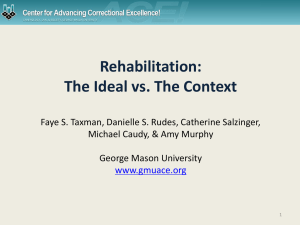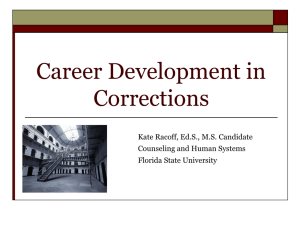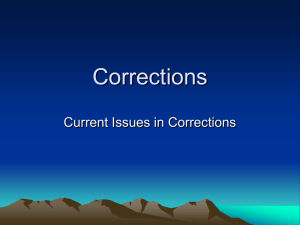The RAND Corporation is a nonprofit institution that helps improve... decisionmaking through research and analysis.
advertisement

CHILDREN AND FAMILIES EDUCATION AND THE ARTS The RAND Corporation is a nonprofit institution that helps improve policy and decisionmaking through research and analysis. ENERGY AND ENVIRONMENT HEALTH AND HEALTH CARE INFRASTRUCTURE AND TRANSPORTATION This electronic document was made available from www.rand.org as a public service of the RAND Corporation. INTERNATIONAL AFFAIRS LAW AND BUSINESS Skip all front matter: Jump to Page 16 NATIONAL SECURITY POPULATION AND AGING PUBLIC SAFETY SCIENCE AND TECHNOLOGY TERRORISM AND HOMELAND SECURITY Support RAND Purchase this document Browse Reports & Bookstore Make a charitable contribution For More Information Visit RAND at www.rand.org Explore the RAND Corporation View document details Limited Electronic Distribution Rights This document and trademark(s) contained herein are protected by law as indicated in a notice appearing later in this work. This electronic representation of RAND intellectual property is provided for noncommercial use only. Unauthorized posting of RAND electronic documents to a non-RAND website is prohibited. RAND electronic documents are protected under copyright law. Permission is required from RAND to reproduce, or reuse in another form, any of our research documents for commercial use. For information on reprint and linking permissions, please see RAND Permissions. This report is part of the RAND Corporation research report series. RAND reports present research findings and objective analysis that address the challenges facing the public and private sectors. All RAND reports undergo rigorous peer review to ensure high standards for research quality and objectivity. C O R P O R AT I O N How Effective Is Correctional Education, and Where Do We Go from Here? The Results of a Comprehensive Evaluation Lois M. Davis, Jennifer L. Steele, Robert Bozick, Malcolm V. Williams, Susan Turner, Jeremy N. V. Miles, Jessica Saunders, Paul S. Steinberg The research described in this report was sponsored by the Bureau of Justice Assistance and was conducted in the Safety and Justice Program, within RAND Justice, Infrastructure, and Environment. This project was supported by Grant No. 2010-RQ-BX-001 awarded by the Bureau of Justice Assistance to the RAND Corporation. The Bureau of Justice Assistance is a component of the United States Department of Justice, Office of Justice Programs. Points of view or opinions in this document are those of the authors and do not necessarily represent the official position or policies of the U.S. Department of Justice. Library of Congress Cataloging-in-Publication Data is available for this publication. ISBN: 978-0-8330-8493-4 The RAND Corporation is a nonprofit institution that helps improve policy and decisionmaking through research and analysis. RAND’s publications do not necessarily reflect the opinions of its research clients and sponsors. Support RAND —make a tax-deductible charitable contribution at www.rand.org/giving/contribute.html R® is a registered trademark. Cover images via Fuse/Thinkstock (graduate) and viperagp/Fotolia (prison background) © Copyright 2014 RAND Corporation This document and trademark(s) contained herein are protected by law. This representation of RAND intellectual property is provided for noncommercial use only. Unauthorized posting of R AND documents to a non-R AND website is prohibited. RAND documents are protected under copyright law. Permission is given to duplicate this document for personal use only, as long as it is unaltered and complete. Permission is required from RAND to reproduce, or reuse in another form, any of our research documents for commercial use. For information on reprint and linking permissions, please see the RAND permissions page (www.rand.org/pubs/permissions.html). RAND OFFICES SANTA MONICA, CA • WASHINGTON, DC PITTSBURGH, PA • NEW ORLEANS, LA • JACKSON, MS • BOSTON, MA CAMBRIDGE, UK • BRUSSELS, BE www.rand.org Summary Introduction Each year, more than 700,000 incarcerated individuals leave federal and state prisons; within three years of release, 40 percent will have committed new crimes or violated the terms of their release and be reincarcerated. Although a number of factors impede the ability of ex-offenders to successfully reintegrate into communities and, thus, affect recidivism rates, one key factor is that many ex-offenders do not have the knowledge, training, and skills to support a successful return to their communities. Research, for example, shows that ex-offenders, on average, are less educated than the general population: 37 percent of individuals in state prisons had attained less than a high school education in 2004, compared with 19 percent of the general U.S. population age 16 and over; 16.5 percent of state prisoners had just a high school diploma, compared with 26 percent of the general population; and 14.4 percent of state prison inmates had at least some postsecondary education, compared with 51 percent of the general U.S. adult population. Moreover, literacy levels for the prison population also tend to be lower than that of the general U.S. population. This lower level of educational attainment represents a significant challenge for exoffenders returning to local communities, because it impedes their ability to find employment. A lack of vocational skills and a steady history of employment also have an impact, with research showing that incarceration impacts unemployment and earnings in a number of ways, including higher unemployment rates for ex-offenders and lower hourly wages when they are employed. Also, individuals being released to the community face a very different set of job market needs than ever before, given the growing role of computer technology and the need for at least basic computer skills. Given these gaps in educational attainment and vocational skills and the impact they have on ex-offenders, one strategy is to provide education to inmates while they are incarcerated, so that they have the skills to support a successful return to their communities. Historically, support for educational programs within correctional settings has waxed and waned over time as the nation’s philosophy of punishment has shifted from rehabilitation to crime control. Although there is general consensus today that education is an important component of rehabilitation, the question remains: How effective is it in helping to reduce recidivism and improve postrelease employment outcomes? The question is especially salient as the nation as a whole and states in particular have struggled with the need to make spending cuts to all social programs due to the recession of 2008 and its long aftermath. With funding from the Second Chance Act of 2007 (Pub. L. 110-199), the U.S. Justice Department’s Bureau of Justice Assistance awarded RAND a cooperative agreement in 2010 to comprehensively examine the current state of correctional education for incarcerated adults and juveniles, where it is headed, xiii xiv How Effective Is Correctional Education, and Where Do We Go from Here? which correctional education programs are effective, and how effective programs can be implemented across different settings. The study was designed to address the following key questions of importance to the field of correctional education: 1. What is known about the effectiveness of correctional education programs for incarcerated adults? 2. What is known about the effectiveness of correctional education programs for juvenile offenders? 3. What does the current landscape of correctional education look like in the United States, and what are some emerging issues and trends to consider? 4. What recommendations emerge from the study for the U.S. Department of Justice and other federal departments to further the field of correction education, and where are there gaps in our knowledge? What promising practices, if any, emerge from this review and evaluation? To address these questions, we used a mixed-methods approach. This report first presents a summary of the prior systematic literature review and meta-analysis of adult correctional education programs (Davis et al., 2013), which included studies completed between 1980 and 2011. It then presents two new sections: a systematic literature review of primary studies of correctional education programs for juveniles and a nationwide web-based survey of state correctional education directors. We conclude with a set of recommendations for moving the field forward. For purposes of our study, we defined correctional education for incarcerated adults as including the following: • Adult basic education: basic skills instruction in arithmetic, reading, writing, and, if needed, English as a second language (ESL) • Adult secondary education: instruction to complete high school or prepare for a certificate of high school equivalency, such as the General Education Development (GED) certificate • Vocational education or career technical education (CTE): training in general employment skills and in skills for specific jobs or industries • Postsecondary education: college-level instruction that enables an individual to earn college credit that may be applied toward a two- or four-year postsecondary degree. To meet our definition of correctional education, the program had to be administered at least partly within a correctional facility. Programs that also included a postrelease transition component remained eligible as long as part of the program was administered in a correctional setting. For the juvenile program systematic review, we define incarcerated youth as individuals under age 21 who are legally assigned to correctional facilities as a result of arrest, detainment for court proceedings, adjudication by a juvenile court, or conviction in an adult criminal court (Office of Juvenile Justice and Delinquency Prevention, 2013). We define correctional education as any academic or vocational education/CTE program provided within the correctional facility setting, regardless of jurisdiction. As with our adult review, we permitted eligible Summary xv interventions for juveniles to include an aftercare (postrelease) component, but the interventions had to be delivered primarily in the correctional facility. How Effective Are Correctional Education Programs for Incarcerated Adults? In terms of the effectiveness of correctional education programs for incarcerated adults, early reviews in this area found inconclusive evidence to support their efficacy—a finding that contributed to the popular belief that “nothing works” in prisoner rehabilitation; however, this conclusion may have been premature, given that appropriate analytic techniques had not been developed. More recent reviews, using meta-analysis techniques, question the conclusions of the earlier work, finding evidence of a relationship between correctional education program participation before release and lower odds of recidivating after release (Wilson, Gallagher, and MacKenzie, 2000; MacKenzie, 2006; Aos, Miller, and Drake, 2006). However, the most recent meta-analyses (Aos, Miller, and Drake, 2006; MacKenzie, 2006) did not consider employment outcomes; thus, whether program participation is associated with postrelease success in the labor market remained unclear. These earlier reviews provide the context for the current systematic review and metaanalysis. Our systematic review scanned the universe of potential documents to compile all available empirical research studies that examine the effect of correctional education programs on the three outcomes of interest—recidivism, postrelease employment, and reading and math scores. This search yielded 1,112 documents, of which 267 were identified as primary empirical studies. To be in our meta-analysis, the study needed to meet three eligibility criteria: (1) evaluate an eligible intervention, defined here as an educational program administered in a jail or prison in the United States published (or released) between January 1, 1980, and December 31, 2011; (2) measure the effectiveness of the program using an eligible outcome measure, which for our meta-analysis included recidivism, postrelease employment, and achievement test scores; and (3) have an eligible research design, which, for our purposes, is one where there is a treatment group comprising inmates who participated in or completed the correctional education program and a comparison group of inmates who did not. Of the 267 primary empirical studies, 58 met all three eligibility criteria.1 With respect to recidivism, based on the higher-quality research studies, we found that, on average, inmates who participated in correctional education programs had a 43 percent lower odds of recidivating than inmates who did not, thus indicating that correctional education is an effective strategy for reducing recidivism.2 This estimate is based only on nine effect sizes from studies that met higher levels of rigor (i.e., earned 4s or 5s on the Maryland Scientific Methods Scale), but the results were very similar even when the lower-quality studies were included in the analysis. This translates to a reduction in the risk of recidivating of 13 percentage points for those who participated in correctional education programs versus those who did not. 1 Our recidivism analysis is based on 71 effect sizes from 50 studies, our employment analysis is based on 22 effect sizes from 18 studies, and our test score analysis is based on nine effect sizes from four studies. 2 We define recidivism a number of ways in the individual studies reviewed, including reoffending, rearrest, reconviction, reincarceration, technical parole violation, and successful completion of parole. In our pool of 50 studies that had recidivism outcomes, the majority used reincarceration as the outcome measure (n = 34). xvi How Effective Is Correctional Education, and Where Do We Go from Here? When aggregating across 18 studies that used employment as an outcome, we found that the odds of obtaining employment postrelease among inmates who participated in correctional education (either academic or vocational/CTE programs) were 13 percent higher than the odds for those who did not. However, the findings are only suggestive about whether correctional education is an effective strategy in improving postrelease employment outcomes because only one of the 18 studies was of higher quality (level 4 or higher), thus limiting our ability to make a more definitive statement. When aggregating across four studies that used achievement test scores as an outcome, we found that learning gains in both reading and math among inmates exposed to computer-assisted instruction were similar to learning gains made by inmates taught through traditional (face-to-face) instruction methods.3 Although doing a formal cost-effectiveness analysis was beyond the scope of this study, we wanted to provide some context for what the meta-analysis findings mean. Focusing on the outcome of recidivism and using a hypothetical pool of 100 inmates, we compared the direct costs of correctional education programs and of incarceration itself. We found that the direct costs of reincarceration were far greater than the direct costs of providing correctional education. More specifically, for a correctional education program to be cost-effective—or breakeven—we estimated that it would need to reduce the three-year reincarceration rate by between 1.9 percentage points and 2.6 percentage points. Given that our findings indicate that participation in correctional education programs is associated with a 13-percentage-point reduction in the risk of reincarceration three years following release, correctional education programs appear to far exceed the break-even point in reducing the risk of reincarceration. We also note that the results are likely to be conservative, because they do not include the indirect costs of reincarceration. How Effective Are Correctional Education Programs for Juvenile Offenders? When it comes to assessing correctional education programs for juvenile offenders, we face a fundamental difference between juvenile and adult correctional policy: Juveniles in the United States have a right to a public education. Therefore, all programs for incarcerated youth include an educational component. This means that the question facing policymakers is not whether to provide education services for juveniles in correctional facilities, but which types of programs are most effective. The meta-analytic approach in our adult analysis included many types of correctional education, each of which was compared with a no-correctional-education scenario. However, that approach is less well suited to studying the effectiveness of juvenile correctional education programs, because correctional education programs are typically present in all juvenile facilities. Instead, our approach to synthesizing research on juvenile correctional education was to undertake a systematic review, in which we screened and evaluated articles using the same criteria as we used in our adult meta-analysis. But rather than aggregating estimated effect sizes across studies that are testing widely different hypotheses for treatment versus comparison groups, we focus on describing the balance of evidence favoring the types of interventions examined in the literature we reviewed. Altogether, the document search process resulted in 1,150 citations for title-and-abstract screening, which, in turn, led to 157 manuscripts eligible for full-text screening. Of those, 3 Three of the four studies, representing seven effect sizes, were of higher quality. Summary xvii 18 studies were deemed eligible for the systematic review by having met three criteria: (1) be an eligible intervention, defined as any academic or vocational education/CTE intervention program, with an eligible population, defined as consisting primarily of individuals age 20 or below, in an eligible setting, defined as any facility regardless of jurisdiction (i.e., local, state) to which juveniles are confined because of arrest, court proceedings, or adjudication/conviction; (2) use eligible outcome measures, defined as any measure of recidivism (e.g., rearrest, reconviction, or reincarceration), postrelease employment, academic attainment (e.g., GED or high school completion), and academic performance (e.g., test scores in reading and mathematics); and (3) have an eligible research design. This includes a comparison-group design in which a group of incarcerated juveniles who received an intervention is compared with a group of incarcerated juveniles who did not, or who received a different version of the treatment. We also included a class of approaches called single-case designs, which involve systematically introducing an intervention with one or a few students in an effort to demonstrate causal effects on outcomes such as participant behavior or learning. These studies typically include a large number of pre- and post-intervention outcome measurements, allowing students to function as their own controls. Because these designs usually focus on only a handful of participants, they typically preclude traditional hypothesis testing. This means that their findings cannot be generalized to a larger, hypothetical population of interest. Our systematic review reveals great heterogeneity in terms of interventions, methods, and outcomes of interest. Among the 18 eligible studies we identified (16 comparison-group studies and two well-executed single-case design ones), we classified the interventions into six categories—Corrective Reading (a commercially packaged curriculum), computer-assisted instruction, personalized instruction, other remedial education, vocational education, and GED completion. Studies in the first two categories focused on packaged and branded reading interventions (Corrective Reading, Read 180, Fast ForWord, and TUNEin to READING) and focused on reading performance as the dependent variables of interest. Studies in the latter three categories focused on a broader set of outcomes, including not only reading and mathematics performance but also measures such as diploma completion, postrelease employment, and postrelease recidivism. Given the small number of studies in each category, we cannot easily extrapolate the effects of differential dosages or implementation approaches. However, taken in conjunction with the broader research literature on each of the interventions examined, our systematic review does identify two interventions that show particular promise: Read 180 (for reading improvement) and Florida’s Avon Park Youth Academy (for diploma completion and postrelease employment). Both of these interventions are supported by a large and rigorous study within juvenile correctional settings, and the effectiveness of Read 180 is further substantiated by several large and well-executed studies outside of correctional facilities. Beyond these compelling studies, we find that evidence for two other packaged interventions, Corrective Reading and TUNEin to Reading, is positive, but the underlying studies are too small to warrant generalization. Evidence concerning vocational education/CTE and GED completion is also positive, but the underlying research designs are vulnerable to selection bias. This limits the quality of conclusions that can be drawn about these programs. xviii How Effective Is Correctional Education, and Where Do We Go from Here? What Is the Current Correctional Education Landscape and What Trends Are Important? When we began the correctional education study, we recognized early on that the 2008 recession had a substantial effect on the field of correctional education, with many states reporting cuts in funding for programs and changes to their delivery models for educating incarcerated adults. This means that today correctional education in the United States likely looks very different from correctional education during the time that many of the studies in the meta-analysis and adult systematic review were undertaken. Understanding these differences helps us to put our review results in context and provides the basis for forward-looking policy recommendations. In July 2013, we fielded the RAND Correctional Education Survey to help fill a critical void in our understanding of the organization and delivery of academic and vocational education/CTE to incarcerated adults. This web-based survey of correctional education directors in all 50 states provides us with insights into how states dealt with the recession of 2008, how correctional education is currently provided to incarcerated adults in the United States, what technology is being used, and how states fund correctional education. We also gathered information on preparations for the new 2014 GED exam. We classified the size of state by the adult prison population in 2012 and considered small states to have an adult prison population in the range 1–24,999; medium states, in the range 25,000–49,999; and large states, 50,000 or more adult prisoners. The overall response rate was 46 out of 50 states, or 92 percent. Of these 46, 42 completed the entire questionnaire, and four provided only partial responses to the survey. Forty of the respondents had responsibility for both adult correctional education and vocational training in their state; five respondents for academic education only; and one respondent for vocational training only. Variation in Correctional Education Programming Across the States In 2013, most states offered adult basic education, GED courses, and vocational education/ CTE programs, and most reported having special education courses available. Higher-level educational programming such as adult secondary education and postsecondary education was offered in 32 of the states, although smaller states were less likely to do so. Postsecondary education courses today in 28 states are primarily paid for by the individual inmate or by family finances; in 16 states, state funding is used to cover the costs of postsecondary education, and 12 states reported using college or university funds. Participation in correctional education programs is mandatory in 24 states for adult inmates without a high school diploma or GED, and in 15 states it is mandatory for adults below a certain grade level, with smaller states less likely to require mandatory participation. An emerging trend is a growing emphasis on providing vocational education/CTE programming that will lead to industry or nationally recognized certifications. Smaller states were more likely to emphasize vocational education/CTE training for state prisoners than mediumsized or large states. Impact of the 2008 Recession The effect of the 2008 recession was an overall 6 percent decrease on average in states’ correctional education budgets between fiscal years (FYs) 2009 and 2012. The largest impact on budgets was felt by medium-sized and large states (on average, a 20 percent and 10 percent Summary xix decrease, respectively). Overall, the mean dollars spent per student for correctional education was $3,479 in FY2009, compared with $3,370 in FY2012—this represented a 5 percent decrease on average in the dollars spent per student. The result was a contraction in the capacity of academic education programs and an overall decrease of 4 percent on average in the number of adult students who participated in these programs, with medium-sized and large states experiencing somewhat larger decreases (10 percent and 8 percent, respectively, compared with a 1 percent decrease for small states). In addition, 20 states reduced the number of course offerings for academic programs during this time period. The effect of the staffing and capacity cost-cutting measures on teachers for academic programs was particularly felt in medium-sized and large states. Overall, there was, on average, a 4 percent decrease in the number of academic teachers who were employees. The largest decrease occurred in medium-sized and large states (on average, 44 percent and 20 percent, respectively, compared with a 5 percent decrease for small states). Vocational education/CTE programs seemed to have fared somewhat better during the recession than academic programs in terms of reductions in the number of students enrolled in vocational education/CTE programs and in the number of instructors. On average, there was a 1 percent increase in the number of students enrolled in vocational/CTE programs between FYs 2009 and 2012. However, this appears to be largely driven by an increase, on average, of 7 percent within the smaller states. In comparison, the medium-sized and large states experienced a reduction in the number of students in vocational education/CTE programs, on average, of 4 percent and 11 percent, respectively. There also appears to have been a modest expansion of vocational education/CTE programs in small and medium-sized states during this time period, as evidenced by a modest increase between FYs 2009 and 2012 in the number of vocational education/CTE instructors who were employees (on average 8 percent and 24 percent, respectively for small and medium-sized states). Still, 38 percent of small states and 50 percent of medium-sized states reported that they had reduced the number of course offerings for vocational education/CTE programs in response to budget cuts. Use of Information Technology One of the major trends that will shape the future of work in the 21st century is the growing role of information technology in society, with technological change resulting in an increased demand for a skilled workforce (Karoly, 2013). Further, distance learning and online instruction are growing trends in the United States, with increasingly more educational courses being offered online by either colleges or virtual high schools. Computer-assisted instruction is also appealing in offering the opportunity to tailor instruction and coursework to the needs of the individual student. The importance of computing skills for today’s job market is recognized by state correctional education directors, as reflected by the fact that 24 states reported offering a Microsoft Office certification as part of their vocational education/CTE programs. However, our survey results indicate that the role of computer technology in correctional education is a mixed story. We found that the use of computers for instructional purposes is common, with 39 states reporting the use of desktop computers (either standalone or networked) and 17 states reporting the use of laptops. However, access to the Internet and the use of Internet-based instruction (one-way or interactive) is reported to be limited in states’ correctional facilities. Thirty states reported that only teachers and instructors have access to live Internet technology. In 26 states, xx How Effective Is Correctional Education, and Where Do We Go from Here? inmate students lack access to any Internet technology, and in only 16 states do inmate students have access to simulated Internet programs. In terms of instructional methods that use some type of technology, only ten states reported that they had closed-circuit television, and only a few states reported using it to provide one-way or interactive video/satellite instruction. Readiness for the 2014 GED Exam and Computer-Based Testing The GED is the predominant way that inmates earn their high school equivalency diplomas (Harlow, 2003), and GED completion is often a prerequisite for many vocational training programs. The 2014 GED exam not only represents a more rigorous test, being aligned with the Common Core State Standards (CSS), but will also rely on a new test delivery model— namely, computer-based testing to replace the old paper-and-pencil exam (Lockwood et al., 2013). This represents a profound change to states and one that presents some key challenges. GED completion rates were seen as an important outcome indicator to track by 40 states that took part in our survey. Yet, of the 31 states planning to implement the 2014 GED exam, 14 states expected that the more rigorous GED exam and the use of computer-based testing may have a negative effect on the number of adult inmates who will be prepared to take the new exam, and 16 states expected a negative effect on GED completion rates. This was particularly true for the medium-sized and large states. All but two of the 31 states planning to implement the 2014 GED exam expressed concerns about the new exam and computer-based testing. Nineteen states were concerned about their teachers being adequately prepared to teach the new GED exam, and 24 of the states were concerned about the length of time it may take to prepare students for the more rigorous exam. In addition, 12 of the states reported concerns that limited access to computers may preclude some students from taking the new GED exam. Also, responding directors in 14 of the states reported concerns that their teachers may not be adequately prepared to implement computerbased testing. Other concerns expressed were the cost to the individual student and the cost of the new GED exam to their institutions, with some states considering the adoption of alternative high school equivalency exams. In general, smaller states expressed fewer concerns; however, our survey results suggest that states with the majority of the prison population (i.e., medium-sized and large states) expect to encounter a number of challenges in implementing the new GED exam and test delivery system. What Are Some Key Recommendations for Moving Forward? This study’s key finding is that correctional education is effective in reducing recidivism for incarcerated adults and that there is some evidence that it also is effective, especially vocational education/CTE programs, in improving individuals’ likelihood of postrelease employment. Also, our cost analysis showed that correctional education is highly cost-effective for incarcerated adults: For every dollar spent on correctional education, five dollars are saved on threeyear reincarceration costs. But the available literature provides less certainty on the effectiveness of correctional education for incarcerated juveniles—some practices are clearly promising, but the knowledge base is thin. Still, the debate should no longer be about whether correctional education is effective or cost-effective; rather, the debate should focus on where the gaps in our knowledge are and opportunities to move the field forward. Summary xxi We offer some recommendations and next steps that are drawn from our evaluation results; while this report is to the U.S. Attorney General, these recommendations will also be of interest to other federal departments and agencies focused on reentry. These recommendations are intended to provide a roadmap for building on the gains made to date in educating incarcerated individuals to improve their chances of success upon release and reentry into local communities. Correctional Education for Adults Our survey results provide solid evidence about the dramatic impact the 2008 recession had on correctional education in the United States. The recession and its long aftermath led to a reduction in correctional education spending and a decrease in the number of incarcerated adults who participate in these programs. This raises the question of whether the trade-offs we are making in terms of cost savings today with reductions in educational programming are worthwhile, considering the future costs of reincarceration and the effect that such lost opportunities may have on individuals’ chances of finding employment and being successful in reintegrating back into society. State corrections directors want to know how they can modify their models of education to trim their budgets while still maintaining the effectiveness of their programs. The results of our meta-analysis (Davis et al., 2013) show that correctional education programs are dramatically effective in reducing recidivism, and there is some evidence of improvements to postrelease employment outcomes. We also showed that correctional education programs are highly cost-effective for incarcerated adults. But because of limitations in quality of the evidence base, we cannot answer the other critical questions needed to inform discussions about modifications to educational programming in a resource-constrained environment. We concur with MacKenzie’s (2008) assessment that we still are unable to get at what is inside the “black box” of what works in correctional education, to answer such questions as: • What dosage is associated with effective programs, and how does it vary for different types of academic programs and students? • What models of instruction and curriculum delivery (e.g., one-on-one, traditional classroom lectures, computer-based learning) are most effective in a correctional environment? • Who benefits most from different types of correctional education programs? • What principles from adult education and learning may be applicable to correctional education? Thus, we recommend the following to help address these concerns: • Focus research and evaluation efforts at the federal and state levels to address these questions so that policymakers and state correctional education directors can make informed trade-offs in budget discussions. • Have federal and state governments and philanthropy fund (1) evaluations of programs that illustrate different educational instructional models, with the goal of getting inside the black box; (2) evaluations of programs that are trying innovative strategies to implement technology and leverage distance learning in the classroom; and (3) an analysis of what lessons from the larger literature on adult education may be applied to correctional education. xxii How Effective Is Correctional Education, and Where Do We Go from Here? • Have the federal government monitor and assess the impact of the new GED and computer-based testing on correctional education implementation and outcomes. Consider opportunities to provide technical assistance to states in helping educators teach the material for the more-rigorous content in the new GED. In juvenile correctional settings, technical assistance for implementing the new Common Core State Standards, which have influenced the move toward a more-rigorous GED, is also likely to be needed. • Conduct new research on instructional quality in correctional education settings, and on ways to leverage computer technology to enhance instruction in correctional settings. • Given the changes in the U.S. economy and the shifting needs of the 21st century workforce, conduct an assessment at the federal and state levels about what such changes mean for the criminal justice–involved population. Consider a summit at the state and federal levels with private industry about what opportunities are available to formerly incarcerated individuals and what skills will be needed in the future. Correctional Education for Juveniles Based on our systematic review of the literature on education provided to juveniles in institutional settings, we believe that the field is ripe for larger-scale randomized trials. Two of the studies we reviewed, Loadman et al.’s (2011) Read 180 study and the National Council on Crime and Delinquency’s (2009) Avon Park study, suggest that such studies, though challenging to undertake, are feasible. The literature is also ripe for rigorous evaluations of natural experiments, such as Aizer and Doyle’s (2013) study of the effects of juvenile incarceration using naturally occurring random assignment to harsh judges. Studies that take advantage of rigorous causal methods in juvenile settings can shed much-needed light on what works in these settings. Several of the smaller randomized trials we include in our review have noted the difficulties of high student turnover in correctional facilities and of simply gaining permission to undertake research in these facilities (Shippen et al., 2012; Calderone et al., 2009). As such, we recommend that the focus be on developing larger-scale randomized trials and rigorous evaluations of natural experiments. Such research efforts will clearly take time to develop and execute. They will ideally be realized through long-term partnerships between researchers and correctional facilities. Because such partnerships take time to establish, there may also be a federal role in galvanizing them. The U.S. Department of Education Institute of Education Science’s recent grant program for supporting research partnerships between school systems and researchers offers one potential model. Informed by such partnerships, facilities can make increasingly evidence-based decisions that not only improve their students’ prospects but also reduce the social incidence of crime and delinquency. Improving the Evidence Base In our meta-analytic report (Davis et al., 2013), we laid out a number of recommendations to improve the evidence base for adult correctional education. Those recommendations also pertain to juvenile correctional education and merit summarizing here. We recommend that the federal and state governments and philanthropy invest in well-designed evaluations of correctional education programs and use funding and grant mechanisms to encourage improvements in four areas to further develop the evidence base for correctional education: Summary xxiii • Apply stronger research designs to help establish a causal relationship between correctional education participation and successful outcomes for inmates to help rule out the possibility of selection bias. In this context, identifying the appropriate comparison groups is important, as is establishing a study registry to help sort out the different effect sizes found across studies. • Measure program dosage to help put the findings from individual studies in their proper contexts. The lack of dosage information means that there is little to no empirical evidence that can help inform policymakers on “how much” correctional education is necessary to produce a change in the desired outcomes. • Identify program characteristics to help policymakers identify promising or evidencebased programs that could be potentially replicated in other settings and specific exemplary programs. • Examine more proximal indicators of program efficacy to help better refine the process through which correctional education helps shape how former inmates re-integrate into the community. This includes understanding how improving the skills and abilities of inmates (i.e., “human capital” in economics parlance) could, in turn, improve former inmates’ chances of continuing education/training upon release and then finding gainful employment. In addition, a study registry of correctional education evaluations would further aid in developing the evidence base in this field to help inform policy and programmatic decisionmaking. Implications of Broader Trends in Corrections for Correctional Education Several trends in the field of adult and juvenile corrections have important implications for correctional education that merit further consideration. First, many states are undertaking measures to reduce the size of their state prison population using a variety of means. This includes both “front-end” strategies—such as reducing prison admissions, diverting offenders to countyrather than state-level institutions, or changing felonies to misdemeanors—and “back-end” strategies—such as reducing sentence lengths through earned credits or good time and revocations for probationers and parolees. All these changes in the correctional landscape have implications for how we think about providing academic education and vocational education/CTE to incarcerated adults. For example, there is California’s Public Safety Realignment, where county jails now have some inmates serving sentences of two, three, or more years instead of the typical length of stay of two to three months. However, county jails are not set up to provide rehabilitative services over the long term, including academic programs and vocational/ CTE programs. The result of various states and localities implementing strategies to keep lowlevel offenders at the local level is that, in some instances, we may end up with a two-tiered system of education where, ironically, more serious offenders who serve their sentence in state prison may have better access to correctional education programs than low-level offenders who serve their sentences in county jails. Such policy changes also raise other questions: Are there differences in access to academic education and vocational education/CTE programs depending on the setting where one serves one’s sentence? Are there differences in educational and employment outcomes for offenders who serve their time at the local level compared with offenders serving their sentence in state prison systems? xxiv How Effective Is Correctional Education, and Where Do We Go from Here? Second, a long-term trend in the field of juvenile corrections is to keep youth in the community if at all possible instead of placing them in correctional institutions, and to keep them at the local versus the state level. Our systematic review focused on what works with incarcerated youth in part because the broader literature on educational interventions for juvenile offenders outside of correctional facilities is even more nebulous. An important direction for future research is to identify interventions that improve juveniles’ educational, employment, and recidivism outcomes in less-restrictive settings, such as alternative schools or traditional schools. To guide policy improvements, stronger federal reporting requirements about local correctional education practices could help facilitate improved state and local comparisons of program effects. Whether collected federally or privately, a central repository of such information (e.g., staffing levels and expertise, curriculum used, hours of instruction provided, types of programs offered) would provide a valuable tool to policymakers and researchers alike. We recommend that policymakers seek to assess and understand the implications of these trends in the field of corrections with respect to their impact on correctional education. Concluding Thoughts There are more than 2 million adults incarcerated in the United States. This study demonstrates that education programs can help adults get back on their feet upon release from prison and help juveniles involved with the juvenile justice system to continue with their education. Education programs are also highly cost-effective in helping to reduce recidivism. States will continue to operate in a reduced funding environment for the near future. The findings and recommendations we present here are intended to ensure that, moving forward, we understand how best to leverage academic education and vocational education/CTE programs to improve the reentry outcomes of incarcerated adults and juveniles.






